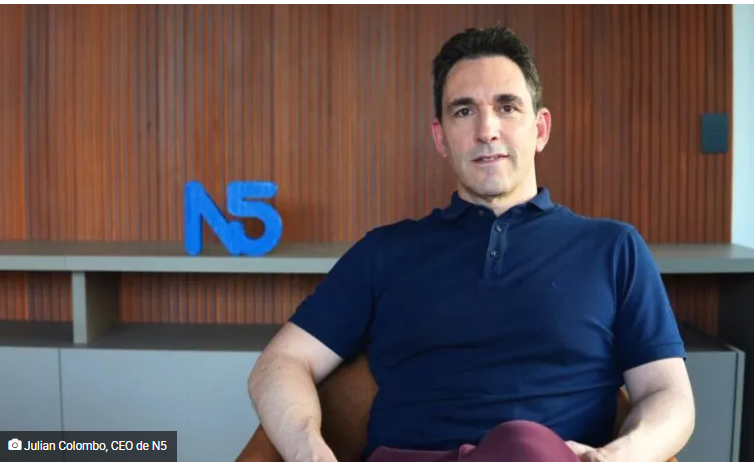At N5, 98% of customers came in directly, which allowed us to build a solid reputation from the beginning.

Mexico is going through a change in the financial sector; However, what feels like a tension between traditional banking and fintech is seen as a power struggle that is turning into a race towards modernization.
“Over the past decade, a very clear trend has emerged: the creation of financial software companies aimed at the unbanked or those who were dissatisfied with their bank. This is how much more agile fintechs were born, designed to solve specific problems quickly and efficiently. With the pandemic, all this accelerated. Branches ceased to be an option, and traditional banks began to have operational difficulties. In that context, many people tried a fintech for the first time… and they were not disappointed. That positive experience reduced resistance to this type of company, at the same time that their financial results began to take off,” said Julian Colombo, CEO of N5, a company dedicated to providing software for banks, insurance companies and some other institutions in the financial industry or payment methods
Fintechs burst onto the scene in Mexico and Latin America, seducing users with agile, digital, and experience-focused services. Companies such as Nubank or Mercado Pago that began as light alternatives, today have the market value, number of users and profitability comparable to banks with more than a century of history.

The fintech ecosystem in Mexico and Latin America continues its dizzying growth, driven by technological innovation and a growing demand for accessible and efficient financial services.
According to data from Finnovista, there are currently more than 650 active fintech startups in Mexico, which positions the country as the second most important ecosystem in the region, only behind Brazil.
Colombo pointed out that, although banking is historically risk-averse and conservative, the pandemic accelerated the need for digital transformation, opening opportunities for fintechs. Mexican consumer confidence in these new financial companies grew as they demonstrate solid economic results and receive significant rounds of investment.
“In many cases, resellers or distributors have a great advantage: they have been working with banks for decades, selling them multiple solutions, and they already have their trust. That’s where the value of the reseller comes in: it evaluates a product, validates it and says, “I put my signature; This is great and can make a difference.” That credibility opens doors. In our case, we were lucky that 98% of our customers came directly to N5. Only later did we start working with resellers so that they could bring our product to banks. But for many companies – especially the smallest ones or those that do not yet have a recognized product – the role of the distributor is key,” explained Julián Colombo during the interview with IT Sitio.
The executive warns about common mistakes that are usually made in these processes. The most serious, according to the CEO of N5, is to opt for generic solutions. “Banking is a very specific industry. Generalist software does not work well. Solutions designed for the complexity of the financial sector must be developed.”
Another frequent failure is the so-called “purchase with the rearview mirror”, which translates into investing in tools that were a trend five or ten years ago, but that are obsolete today, therefore, building your own artificial intelligence solutions without the necessary specialization can generate more entropy than efficiency.
N5, on the other hand, proposes an architecture designed from the financial core, with an orchestration of systems based on artificial intelligence. “We have a ‘conductor’ who coordinates multiple AI agents. Each one is hyper-trained for a specific task, from customer service to fraud detection or onboarding new users,” explains Colombo. This model not only integrates data, but allows for faster, more personalized, and cost-effective decision-making.
Artificial intelligence as the backbone of the financial future
Artificial intelligence became the central pillar of N5’s technology strategy. For Colombo, there is no turning back from this trend. “It is the most demanded technology in the financial sector, by far. What used to be done by a very intelligent human, today can be done by a network of well-trained AI agents.”
Data shared by N5 assures that serving a customer with a set of artificial intelligence agents can cost just 4% of what it would cost with a human. Even so, user satisfaction tends to be higher. “Customers receive faster responses, without errors, and with 24/7 availability,” says Colombo.
This automation does not necessarily mean the replacement of the human factor, but rather its relocation to more strategic tasks. Hence, another booming technology is the measurement of performance and incentives through integrated platforms, which help optimize talent within organizations.

Digital banks are leading the way in fully digital onboarding, offering greater accessibility to unbanked users.
Mexico at the center of the revolution
For N5, Mexico represents a strategic market. Not only because of its size and potential, but also because of the growing openness towards digital transformation. “Mexico is a priority for us. In fact, we are about to close the largest contract in the company’s history with a very important Mexican bank,” Colombo advances. Although he does not reveal the name of the institution, he makes it clear that it is an agreement that will consolidate N5 as a key technology partner in the country.
This type of alliance not only strengthens the position of technology companies in the financial ecosystem, but also pushes other institutions to follow the same path. In this context, the competition between traditional banking and fintech becomes less of a battle and more of an inevitable convergence.
The advance of financial digitalization has a positive consequence that cannot be ignored, and that is inclusion. According to the National Banking and Securities Commission (CNBV), there are still more than 40 million unbanked people in Mexico. Digital platforms, mobile apps, and solutions like those developed by N5 can help bridge this gap, bringing financial services to populations that previously had no access.
In this sense, the modernization process is more than a competitiveness strategy: it is a tool to democratize finance. “Technology makes it possible to provide quality services at a low cost, even in remote or underserved areas. That changes the rules of the game,” concludes Colombo.


